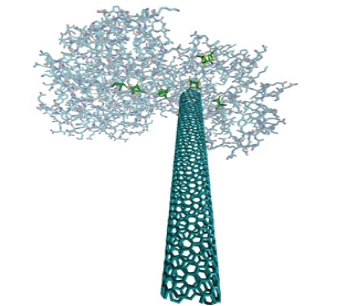Home > Press > "Wiring up" enzymes for producing hydrogen in fuel cells
 |
| Computer graphic representation of a single-walled carbon nanotube (elongated structure) "wired up" to a hydrogenase enzyme. Courtesy of Michael J. Heben, National Renewable Energy Laboratory |
Abstract:
Researchers in Colorado are reporting the first successful "wiring up" of hydrogenase enzymes. Those much-heralded proteins are envisioned as stars in a future hydrogen economy where they may serve as catalysts for hydrogen production and oxidation in fuel cells. Their report, describing a successful electrical connection between a carbon nanotube and hydrogenase, is scheduled for the Nov. issue of ACS' Nano Letters, a monthly journal.
"Wiring up" enzymes for producing hydrogen in fuel cells
Golden, CO | Posted on November 14th, 2007In the new study, Michael J. Heben, Paul W. King, and colleagues explain that bacterial enzymes called hydrogenases show promise as powerful catalysts for using hydrogen in fuel cells, which can produce electricity with virtually no pollution for motor vehicles, portable electronics, and other devices. However, scientists report difficulty incorporating these enzymes into electrical devices because the enzymes do not form good electrical connections with fuel cell components. Currently, precious metals, such as platinum, are typically needed to perform this catalysis.
The researchers combined hydrogenase enzymes with carbon nanotubes, submicroscopic strands of pure carbon that are excellent electrical conductors. In laboratory studies, the researchers demonstrated that a good electrical connection was established using photoluminescence spectroscopy measurements. These new "biohybrid" conjugates could reduce the cost of fuel cells by reducing or eliminating the need for platinum and other costly metal components, they say.
####
For more information, please click here
Contacts:
Science Inquiries: Michael Woods, editor
General Inquiries: Michael Bernstein
202-872-4400
Michael J. Heben, Ph.D.
Energy Sciences
National Renewable Energy Laboratory
Golden, Colorado 80401
Phone: 303-384-6641
Fax: 303-384-6432
Paul W. King, Ph.D.
Energy Sciences
National Renewable Energy Laboratory
Golden, Colorado 80401
Phone: 303-384-6277
Fax: 303-384-6150
Copyright © American Chemical Society
If you have a comment, please Contact us.Issuers of news releases, not 7th Wave, Inc. or Nanotechnology Now, are solely responsible for the accuracy of the content.
| Related Links |
| Related News Press |
Discoveries
![]() Chemical reactions can scramble quantum information as well as black holes April 5th, 2024
Chemical reactions can scramble quantum information as well as black holes April 5th, 2024
![]() New micromaterial releases nanoparticles that selectively destroy cancer cells April 5th, 2024
New micromaterial releases nanoparticles that selectively destroy cancer cells April 5th, 2024
![]() Utilizing palladium for addressing contact issues of buried oxide thin film transistors April 5th, 2024
Utilizing palladium for addressing contact issues of buried oxide thin film transistors April 5th, 2024
Announcements
![]() NRL charters Navy’s quantum inertial navigation path to reduce drift April 5th, 2024
NRL charters Navy’s quantum inertial navigation path to reduce drift April 5th, 2024
![]() Discovery points path to flash-like memory for storing qubits: Rice find could hasten development of nonvolatile quantum memory April 5th, 2024
Discovery points path to flash-like memory for storing qubits: Rice find could hasten development of nonvolatile quantum memory April 5th, 2024
Energy
![]() Development of zinc oxide nanopagoda array photoelectrode: photoelectrochemical water-splitting hydrogen production January 12th, 2024
Development of zinc oxide nanopagoda array photoelectrode: photoelectrochemical water-splitting hydrogen production January 12th, 2024
![]() Shedding light on unique conduction mechanisms in a new type of perovskite oxide November 17th, 2023
Shedding light on unique conduction mechanisms in a new type of perovskite oxide November 17th, 2023
![]() Inverted perovskite solar cell breaks 25% efficiency record: Researchers improve cell efficiency using a combination of molecules to address different November 17th, 2023
Inverted perovskite solar cell breaks 25% efficiency record: Researchers improve cell efficiency using a combination of molecules to address different November 17th, 2023
![]() The efficient perovskite cells with a structured anti-reflective layer – another step towards commercialization on a wider scale October 6th, 2023
The efficient perovskite cells with a structured anti-reflective layer – another step towards commercialization on a wider scale October 6th, 2023
Fuel Cells
![]() Current and Future Developments in Nanomaterials and Carbon Nanotubes: Applications of Nanomaterials in Energy Storage and Electronics October 28th, 2022
Current and Future Developments in Nanomaterials and Carbon Nanotubes: Applications of Nanomaterials in Energy Storage and Electronics October 28th, 2022
|
|
||
|
|
||
| The latest news from around the world, FREE | ||
|
|
||
|
|
||
| Premium Products | ||
|
|
||
|
Only the news you want to read!
Learn More |
||
|
|
||
|
Full-service, expert consulting
Learn More |
||
|
|
||








